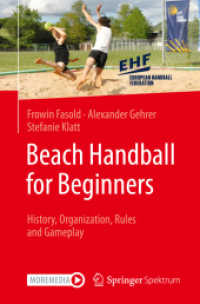- ホーム
- > 洋書
- > 英文書
- > Science / Mathematics
Full Description
Sustainable Brownfield Regeneration presents a comprehensive account of UK policies, processes and practices in brownfield regeneration and takes an integrated and theoretically-grounded approach to highlight best practice.
Brownfield regeneration has become a major policy driver in developed countries. It is estimated that there are 64,000 hectares of brownfield land in England, much of which presents severe environmental challenges and lies alongside some of the most deprived communities in the country. Bringing such land back into active use has taken on a new urgency among policymakers, developers and other stakeholders in the development process. Frequently, however, policy thinking and practice has been underpinned by 'silo' mentalities, in which integrated and multidisciplinary approaches to problem-solving have been limited.
The book has two principal aims. The first is to examine the ways in which science and social science research disciplines can be brought together to help solve important brownfield regeneration issues, with a focus on the UK. The second is to assess the efficiency and effectiveness of different types of regeneration policy and practice, and to show how 'liveable spaces' can be produced from 'problem places'. The Thames Gateway in the south of England and Greater Manchester in the North of England are shown as examples of how brownfield regeneration projects are developing in an era where sustainability is high on the policy agenda.
From the Foreword by Paul Syms, National Brownfield Advisor, English Partnerships:
'Ensuring the effective and efficient reuse of brownfield land is an essential part of the British Government's land use policies in support of sustainable communities. [This book] recognises that reusing brownfield land is not just about over-coming technical issues to remove contamination or other physical problems with the ground. It highlights the importance of engaging with the many different stakeholders whose opinions and concerns need to be taken into account if sustainable outcomes are to be achieved. The authors also recognise that brownfield land reuse is not just about building new homes or places of employment - the creation of new green spaces can be just as important.'
Contents
Notes on the Contributors . Acknowledgements .
PART 1 INTRODUCTION .
1 Introduction.
Tim Dixon and Mike Raco.
1.1 Background.
1.2 Aims and objectives.
1.3 Structure of the book.
2 Researching Sustainability: The Possibilities and Limitations of Cross-cutting Research in the Urban.
Environment .
Mike Raco and Tim Dixon.
2.1 Introduction.
2.2 Intellectual disciplines, interdisciplinarity and the construction of knowledge.
2.3 The rise and rise of the sustainability agenda.
2.4 The EPSRC's Sustainable Urban Environments programme and the emergence of the SUBR:IM.
consortium.
2.5 Conclusions: SUBR:IM and new ways of working.
PART 2 REGENERATION .
3 Democracy, Trust and Risk Related to Contaminated.
Sites in the UK.
Philip Catney, Dick Eiser, John Henneberry and.
Tom Stafford.
3.1 Introduction.
3.2 Contaminated land in the UK: context and policy.
3.3 Democracy, trust and risk in environmental governance.
3.4 Case studies.
3.5 Conclusion.
4 Actor Networks: The Brownfield Merry-Go-Round .
Joe Doak and Nikos Karadimitriou.
4.1 Introduction.
4.2 Actors and their roles.
4.3 Networks and their construction.
4.4 Network processes in brownfield regeneration.
4.5 Conclusion.
5 Heroes or Villains? The Role of the UK Property Development Industry in Sustainable Urban Brownfield Regeneration .
Tim Dixon.
5.1 Introduction.
5.2 The nature and challenge of brownfield development.
5.3 The role of the UK property development industry in brownfield regeneration.
5.4 Survey and interview findings.
5.5 Learning from practice: Thames Gateway and Greater Manchester.
5.6 Towards best practice?.
5.7 A checklist for developers.
5.8 Conclusions.
Acknowledgements.
5A.1 Appendix 1 National developer interviewees and questionnaire sample.
5A.2 Appendix 2 Details of case study interviews.
6 Delivering Brownfield Regeneration: Sustainable Community-Building in London and Manchester .
Mike Raco, Steven Henderson and Sophie Bowlby.
6.1 Introduction.
6.2 Building for the future: visions, practices and the delivery of sustainable urban regeneration sustainability and the politics of space-time.
6.3 Flagship urban brownfield regeneration in the UK: the redevelopment of Salford Quays and.
Paddington Basin.
6.4 Conclusions: lessons for urban development policy.
PART 3 REMEDIATION .
7 Greening Brownfield Land .
Andy Moffat and Tony Hutchings.
7.1 Introduction.
7.2 Background and context.
7.3 A sustainable process for greenspace.
7.4 Contamination.
7.5 Sustainable greenspace.
7.6 The future of greenspace on brownfield land.
7.7 Conclusions.
8 Novel Special-purpose Composts for Sustainable Remediation .
Sabeha Ouki, René van Herwijnen, Michael Harbottle,.
Tony Hutchings, Abir Al-Tabbaa, Mike Johns and.
Andy Moffat.
8.1 Introduction.
8.2 Materials characterisation.
8.3 Experimental design.
8.4 Heavy metals containment in soils.
8.5 Biomass.
8.6 Enhanced compost.
8.7 Magnetic resonance imaging.
8.8 Conclusions.
9 Robust Sustainable Technical Solutions .
Abir Al-Tabbaa, Michael Harbottle and Chris Evans.
9.1 Introduction.
9.2 Sustainability assessment of currently available remediation technologies in the UK.
9.3 Sustainability improvements to remediation techniques.
9.4 Concluding remarks.
10 'The Creature Lurks Within?' Restoring Acid Tar Lagoons .
Simon Talbot, Nigel Lawson and Colin Smith.
10.1 Introduction.
10.2 Acid tar lagoons: a technical introduction.
10.3 Regulating risk on an acid tar lagoon.
10.4 Lesson-drawing from Germany: an appraisal of the state of the art in remediation.
10.5 Conclusions.
PART 4 JOINED-UP SOLUTIONS .
11 Climate Change, Pollutant Linkage and Brownfield Regeneration .
Abir Al-Tabbaa, Sinead Smith, Cecile De Munck,.
Tim Dixon, Joe Doak, Stephen Garvin and Mike Raco.
11.1 Introduction.
11.2 Evidence of impacts of climate change on contaminated land systems.
11.3 Modelling potential impacts of climate change and the creation of green space on contaminated land.
11.4 Climate change mitigation and adaptation.
11.5 Technical adaptation and risk management strategies.
11.6 Stakeholder adaptation key issues and findings.
11.7 Concluding remarks.
Acknowledgements.
12 Evaluating the Sustainability of Brownfield Redevelopment Projects .
Kalliope Pediaditi, Walter Wehrmeyer and Kate Burningham.
12.1 Introduction.
12.2 Sustainability evaluation in brownfield projects.
12.3 The Redevelopment Assessment Framework.
12.4 Conclusion.
12A.1 Appendix.
13 Is Brown the New Green?.
Philip Catney, David N. Lerner, Tim Dixon and Mike Raco.
13.1 Introduction.
13.2 Sustainable brownfield regeneration.
13.3 Sustainability in action.
13.4 Constructing cross-disciplinary research: lessons from the SUBR:IM experience.
13.5 Summary.
Index







